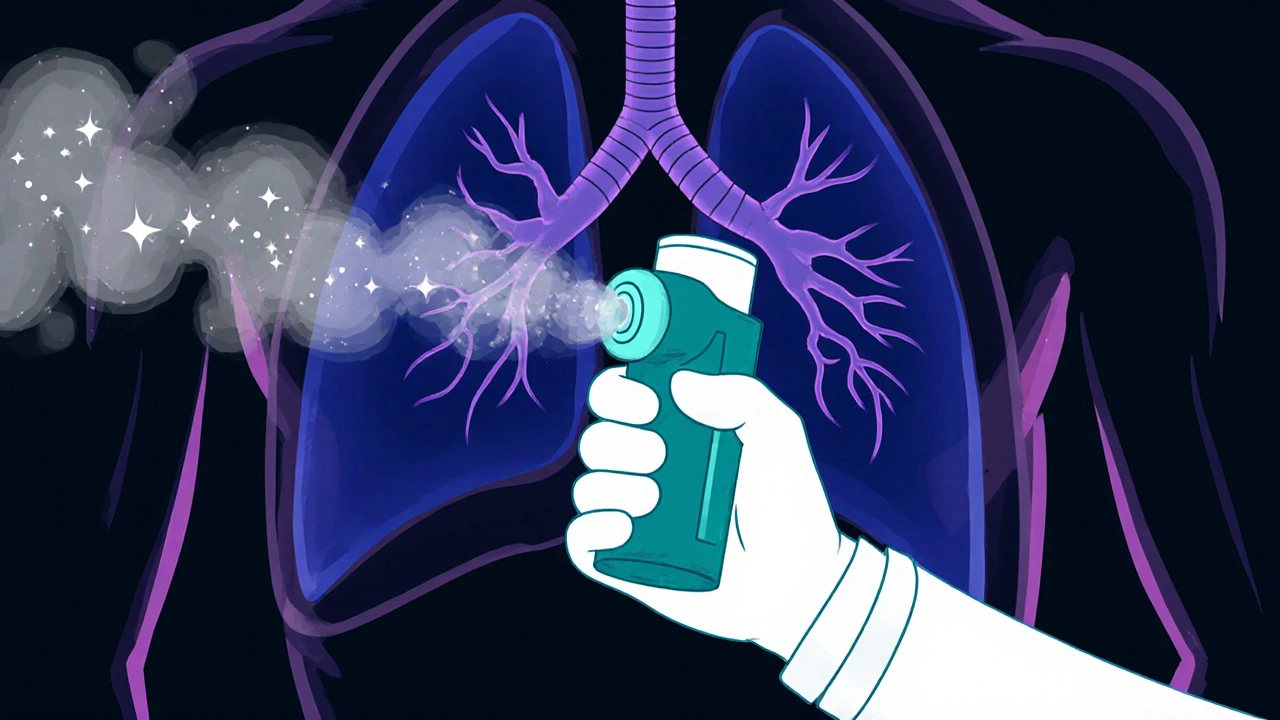Bronchodilator Selection Tool
Find Your Best Bronchodilator Option
Select your condition and needs to get personalized recommendations based on medical evidence
When treating COPD or asthma, Combimist L inhaler is a combination bronchodilator that delivers levosalbutamol and ipratropium in a metered‑dose format provides rapid relief. The Combimist L inhaler offers a convenient twice‑daily dose that targets both bronchial smooth‑muscle relaxation and airway‑secretion reduction.
What is Combimist L Inhaler?
Combimist L combines two active agents: levosalbutamol (a short‑acting β2‑agonist) and ipratropium bromide (an anticholinergic). The device uses a propellant‑free soft mist technology, which creates fine particles that reach deeper lung regions. Because both drugs act through different mechanisms, the inhaler can improve lung function more effectively than a single‑agent device for many patients.
How does the levosalbutamol + ipratropium combo work?
Levosalbutamol binds to β2 receptors on bronchial smooth muscle, triggering a cascade that increases cyclic AMP and leads to muscle relaxation within minutes. Ipratropium, on the other hand, blocks muscarinic M3 receptors, preventing acetylcholine‑induced bronchoconstriction and reducing mucus secretion. The dual action means patients experience quicker symptom relief (thanks to levosalbutamol) while also enjoying a longer‑lasting bronchodilation effect from ipratropium.
Main alternatives on the market
Several inhalers address similar indications, but they differ in composition, dosing, and device type. Below are the most common contenders:
- Albuterol (Ventolin) - a single‑agent short‑acting β2‑agonist administered via a metered‑dose inhaler (MDI) or nebulizer.
- Combivent - combines albuterol and ipratropium in a traditional MDI, typically used for acute COPD exacerbations.
- Spiriva - contains tiotropium, a long‑acting anticholinergic taken once daily via a dry‑powder inhaler (DPI).
- Serevent - delivers salmeterol, a long‑acting β2‑agonist (LABA) also inhaled once daily via DPI.
- Budesonide/Formoterol (Symbicort) - a combination inhaled corticosteroid/LABA used for maintenance therapy rather than rescue.

Head‑to‑head comparison
| Product | Active Ingredients | Dosing Frequency | Onset of Action | Duration of Effect | Device Type |
|---|---|---|---|---|---|
| Combimist L | Levosalbutamol + Ipratropium | Twice daily | 2-5 min | 4-6 hr | Soft‑mist inhaler |
| Ventolin (Albuterol) | Albuterol | Every 4-6 hr PRN | 1-3 min | 4-6 hr | MDI / Nebulizer |
| Combivent | Albuterol + Ipratropium | Every 4-6 hr PRN | 2-5 min | 6-8 hr | MDI |
| Spiriva | Tiotropium | Once daily | 15-30 min | 24 hr | DPI |
| Serevent | Salmeterol | Twice daily | 10-15 min | 12 hr | DPI |
When to choose Combimist L over other options
Here are the situations where the combination inhaler shines:
- Dual‑mechanism need: Patients who still cough or produce thick secretions after a single β2‑agonist will benefit from ipratropium’s anticholinergic effect.
- Twice‑daily routine: For those who prefer a set‑morning/evening schedule rather than multiple PRN doses, Combimist L simplifies adherence.
- Soft‑mist delivery: The mist allows deeper lung deposition, which can be helpful for elderly patients who struggle with the coordination required for MDIs.
- Cost considerations: In many formularies, the combo inhaler is priced similarly to two separate inhalers, delivering better value.
Conversely, you might skip Combimist L if:
- You need a once‑daily long‑acting therapy (tiotropium or salmeterol are better).
- You’re already on an inhaled corticosteroid/LABA regimen for maintenance; adding another rescue inhaler could increase pill burden.
- You have a strong preference for MDIs over soft‑mist devices.

Practical tips for using inhalers effectively
- Prime the device before the first use - pump the inhaler a few times until a fine mist appears.
- Exhale fully, then place the mouthpiece between your teeth, sealing lips around it.
- Inhale slowly and deeply, pressing the dose button at the start of the breath.
- Hold your breath for about 10 seconds to allow medication to settle.
- Rinse your mouth after each dose if you also use an inhaled steroid to reduce oral thrush risk.
Cleaning the inhaler once a week with warm water (no soap) prevents residue buildup that can affect dose consistency.
Frequently Asked Questions
What makes Combimist L different from Combivent?
Combimist L delivers levosalbutamol (the levo‑isomer of albuterol) plus ipratropium in a soft‑mist inhaler, while Combivent uses regular albuterol with ipratropium in a traditional metered‑dose inhaler. The levo‑isomer provides slightly faster bronchodilation and the soft‑mist system improves lung deposition.
Can I use Combimist L as a rescue inhaler for sudden asthma attacks?
Yes, it works within minutes, but if you need a single‑agent rapid‑onset inhaler (like albuterol alone), keep one handy for emergency situations.
Is Combimist L safe for pregnant women?
Both levosalbutamol and ipratropium are classified as Category B for pregnancy in the U.S., meaning animal studies have not shown risk. Nonetheless, always discuss any inhaled medication with your OB‑GYN.
How long can I store an opened Combimist L inhaler?
Most soft‑mist inhalers remain effective for 30 days after opening if kept at room temperature and the cap is tightly closed.
What are common side effects?
Mild tremor, rapid heartbeat, dry mouth, or throat irritation may occur. serious allergic reactions are rare but require immediate medical attention.







Comments
Sarah Unrath
October 19, 2025 AT 21:44 PMI think the soft mist is actually better for older folks who cant master the hand‑breath coordination it’s just easier to use
James Dean
October 19, 2025 AT 23:57 PMThe dual mechanism of levosalbutamol and ipratropium reminds us that asthma management is as much about physics of airflow as it is about chemistry of receptors
Bobby Marie
October 20, 2025 AT 02:10 AMCombimist L hits the sweet spot between speed and duration
Christian Georg
October 20, 2025 AT 04:24 AMWhen you prime the soft‑mist inhaler give it a few pumps until you see a consistent plume 😊
Then inhale slowly at the start of the breath – that’s when the levosalbutamol will start relaxing the smooth muscle within minutes.
Following up with a deep breath holds the medication in the peripheral airways longer, maximizing ipratropium’s anti‑secretory effect.
Regular cleaning with warm water prevents residue that could alter dose delivery.
Christopher Burczyk
October 20, 2025 AT 06:37 AMWhile the author extols Combimist L’s convenience, it must be noted that the therapeutic advantage over an albuterol‑only MDI is marginal in patients without significant mucus hypersecretion, thereby rendering the added cost unjustifiable in many formulary contexts.
Caroline Keller
October 20, 2025 AT 08:50 AMIt’s almost criminal how many prescribers ignore the moral imperative to reduce poly‑pharmacy when a single dual‑action inhaler can spare patients the burden of multiple devices and the silent suffering that follows poor adherence.
dennis turcios
October 20, 2025 AT 11:04 AMHonestly the data isn’t shocking – Combimist L does what any combo should do and the hype feels overblown.
Leo Chan
October 20, 2025 AT 13:17 PMGive Combimist L a try if you struggle with remembering multiple puffs a day – the twice‑daily rhythm can really boost confidence and keep you moving forward.
jagdish soni
October 20, 2025 AT 15:30 PMIn the grand schema of respiratory therapeutics the soft‑mist represents a subtle yet profound shift from brute force delivery to an artful choreography of particle dynamics, a truth many fail to appreciate.
Latasha Becker
October 20, 2025 AT 17:44 PMFrom a pharmacokinetic perspective the enantiomeric purity of levosalbutamol confers a marginally superior beta‑2 receptor affinity compared to the racemic albuterol, yet clinical outcomes often fail to reflect this theoretical advantage.
One must consider the device’s aerosol physics: the soft‑mist generates particles with a mass median aerodynamic diameter (MMAD) of approximately 3 µm, facilitating alveolar deposition, whereas conventional MDIs produce a broader distribution prone to oropharyngeal loss.
Nevertheless, the incremental improvement in forced expiratory volume (FEV₁) observed in head‑to‑head trials is typically within the confidence interval of non‑inferiority, raising the question of whether the distinction is statistically or merely statistically significant.
Furthermore, cost‑effectiveness analyses frequently demonstrate parity with generic albuterol‑ipratropium MDIs when factoring in adherence gains, but such models are highly sensitive to regional pricing structures.
In populations with pronounced mucus hypersecretion, the anticholinergic component of ipratropium undeniably reduces sputum viscosity, yet the magnitude of this effect can be replicated with adjunct mucolytics, which are less costly.
Conversely, in young, otherwise healthy asthmatics the added anticholinergic may confer no appreciable benefit and could increase the risk of dry mouth and urinary retention, especially in males with prostatic hypertrophy.
The dosing frequency of twice daily aligns with circadian variation in airway hyper‑responsiveness, but the therapeutic window remains narrow, demanding precise timing to avoid nocturnal bronchoconstriction.
Device handling also merits scrutiny: soft‑mist inhalers require a priming step and a coordinated breath‑actuation, which may be challenging for patients with severe dyspnea or cognitive impairment.
Training initiatives that incorporate teach‑back methods have been shown to improve technique retention, but the resource investment is non‑trivial.
When comparing Combimist L to long‑acting agents such as tiotropium or salmeterol, the latter provide 24‑hour coverage, rendering them preferable for maintenance therapy rather than acute relief.
It is also imperative to recognize that inhaled corticosteroid/LABA combinations, while primarily maintenance, can be employed as rescue in the form of SMART therapy, blurring the lines between rescue and control medications.
Regulatory labeling classifies both levosalbutamol and ipratropium as Category B for pregnancy, yet the paucity of robust human data warrants a cautious approach in obstetric populations.
From a safety standpoint, the combination does not appear to increase the incidence of cardiovascular adverse events relative to monotherapy, although beta‑agonist induced tachycardia remains a concern in susceptible individuals.
In summary, while Combimist L offers a well‑engineered delivery system and a rational pharmacologic pairing, its clinical superiority is conditional, not universal, and must be weighed against patient‑specific factors, formulary constraints, and the practitioner’s familiarity with device technique.
Therefore, the decision to preferentially prescribe Combimist L should be grounded in a nuanced assessment rather than a blanket endorsement.
parth gajjar
October 20, 2025 AT 19:57 PMThe tragedy of neglecting a soft‑mist inhaler is that countless breaths go unoptimized, a silent lament that echoes through every wheeze.
Maridel Frey
October 20, 2025 AT 22:10 PMFor clinicians considering Combimist L, it is advisable to evaluate the patient’s inhaler technique proficiency, assess the presence of excessive secretions, and verify insurance coverage before making a transition.
Madhav Dasari
October 21, 2025 AT 00:24 AMHey folks, if you’re juggling multiple inhalers, give the twin‑dose soft mist a spin – it might just simplify your day and keep you breathing easy.